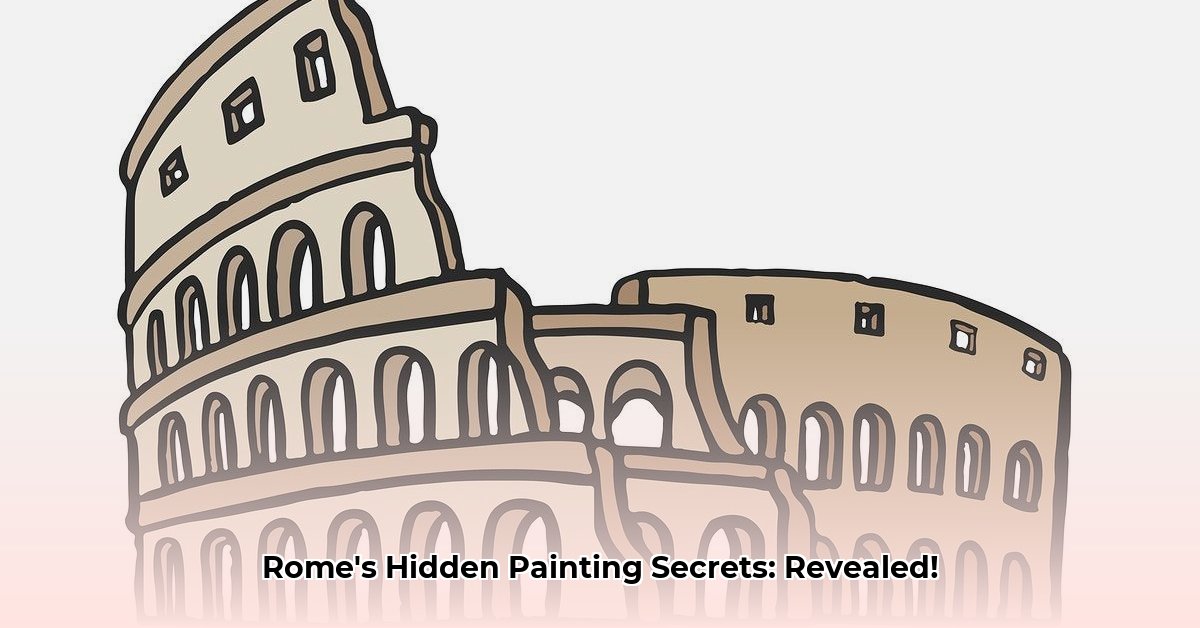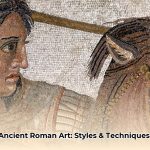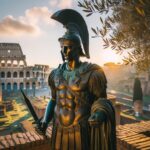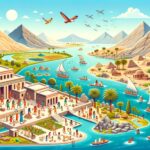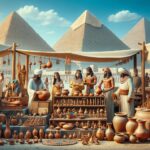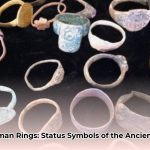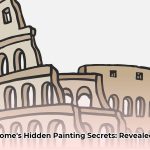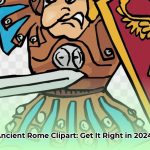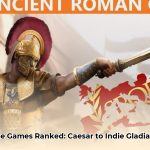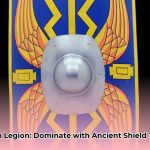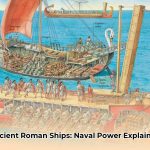Ever wondered what life was truly like in ancient Rome? Forget dry history texts. A vibrant visual record, etched in art, offers an unparalleled glimpse into that world. We’re not just talking colossal statues. Imagine vivid paintings bursting with color, intricate designs within those artworks, and mosaics so detailed they practically narrate stories. These ancient Roman drawings, paintings, and mosaics act as windows into their homes, their deepest beliefs, and their aspirations.
Roman artists, inspired by cultures spanning the Greeks to the Egyptians, ingeniously transformed borrowed ideas into something uniquely Roman. Let’s dive deep into the secrets these artistic treasures reveal about a civilization that continues to captivate us, showcasing a remarkable Roman artistic legacy and innovation.
The Canvas of Daily Life: Beyond Stone & Statues
Roman artwork provides a unique lens into a civilization both familiar and strikingly distinct from our own. Far from being mere copies, Roman creations skillfully adapted and transformed designs from Greek, Etruscan, and Egyptian cultures to meet the specific demands of their dynamic society. From colossal public sculptures to intimate frescoes inside homes, Roman art history consistently demonstrates art’s inherent function. Each piece served a purpose, reflecting status, belief, or social commentary.
Art as a Statement of Strength and Status
Roman sculpture, for instance, transcended mere decoration. It actively broadcasted power and social standing. Consider the imperial portraits: Emperors like Claudius were often depicted with the idealized, partially nude body of Jupiter, holding the god’s scepter and thunderbolt. An eagle, Jupiter’s companion animal, stood at his feet, boldly equating the emperor’s dominion over the Roman Empire to Jupiter’s control over the cosmos. Earlier emperors were clean-shaven, but Hadrian (reigned 117–38 CE) sported a beard, possibly to signify his admiration for Greek intellectual traditions. His portraits contrasted closely cropped facial hair with thick, luxurious curls, showcasing sculptural mastery.
Even within the tranquil setting of private gardens, statues of Aphrodite—inspired by Praxiteles’ famed nude figure—were displayed. Their voluptuous forms and associations with fertility were equated with the lush growth and pleasure of the garden, reinforcing underlying societal values. In elite homes, decorative bronze busts of silenoi, Dionysos’s untamed companions, adorned banquet couches. These objects reinforced messages of merriment and indulgence, highlighting the lavish hospitality and wealth of their owners.
Visualizing Identity: Beyond Marble
Roman portraiture extended beyond the idealized. It embraced a striking realism, capturing the unique individuality of its subjects. Painted portraits, though rare due to material delicacy, offer compelling examples. The Fayum mummy portraits from Roman-ruled Egypt, painted on thin wooden boards using beeswax pigments, capture the expressive faces of the deceased. Details like large, heavy-lidded eyes, narrow chins, and full lips convey individuality, while hairstyles and beards reflect contemporary Roman fashions. Gold details often symbolized divinity and eternity, speaking to the expense lavished on the likeness. Even the intricate hairstyles of prominent Roman women, like the multi-tiered bun of braids seen in some portraits, attest to their wealth and social standing, requiring skilled hairdressers and rich adornments.
Coins, too, served as miniature canvases for imperial messaging. A coin minted after Constantine I became sole emperor (reigned 306–37 CE) depicts him with a youthful, clean-shaven face and thick locks. These features deliberately echoed earlier revered emperors like Augustus and Trajan, visually linking his transformative reign to esteemed predecessors.
Public and Private Narratives
Architectural reliefs, often crafted from terracotta using molds, adorned public buildings, lavish homes, temples, and tombs. These plaques, produced in multiples, formed decorative friezes depicting subjects from mythology to daily life. They were typically painted to enhance visibility from below, with microscopic traces of yellow and red pigment sometimes preserved today. A relief depicting female attendants around a candelabrum or incense burner, for instance, offers a glimpse into ritualistic or domestic scenes.
Roman homes also featured domestic shrines, or lararia, housing bronze statuettes of household gods (Lares) and other venerated deities. These statuettes, like an unidentified goddess seated on an elaborate throne, were central to family worship, emphasizing the deeply interwoven nature of religion and daily life. Even decorative objects like a tall, narrow alabastron, a vessel for precious oils, showcased Roman aesthetic preferences. This particular example, tapering to an elongated point, mimicked costly stone with its opaque, deep-blue color and white veining, highlighting their innovative glass production techniques.
Mastering Color & Canvas: Unveiling Roman Fresco Techniques
Roman frescoes stand as enduring murals, created by applying pigments directly onto wet lime plaster—a testament to sophisticated ancient art preservation. These frescoes offer invaluable insights into Roman life, artistry, and technical prowess. The meticulous preparation, limited color palette, and time-sensitive execution involved showcase incredibly advanced Roman engineering in art. Evolving through distinct styles—from marble imitation to elaborate designs—frescoes mirrored the shifting tastes of Roman society, profoundly influencing future classical art.
The Fresco Foundation: Layers of Longevity
To understand how Romans created frescoes, one must appreciate their foundational precision. This wasn’t merely decoration; it was a vibrant, permanent record. The “al fresco” (meaning “fresh”) technique involved applying pigments onto wet lime plaster, forming a chemical bond that ensured the murals’ remarkable longevity.
The process began with a sturdy foundation of brick or stone. Multiple layers of plaster followed. The initial coat, a rough mix of gritty sand and lime, was sometimes allowed to cure for nearly a year. The critical final layer, the intonaco, crafted from finely ground burned and slaked limestone, provided the smooth, pristine canvas for the artwork.
Pigments and Palettes: Earth’s Hues
How did artists bring these walls to life with such enduring colors, creating the magnificent ancient Roman frescoes? Preparation was paramount. Artists often used charcoal tracings of preparatory drawings, or sinopie, to guide their hand on the wet plaster. Their pigments came directly from nature, yielding a palette of rich, earthy hues that bonded chemically with the lime. Black was derived from charred bones, yellow from ochre, and vibrant reds from cinnabar. Blue, a rare and precious pigment, typically came from lapis lazuli or Egyptian blue, used sparingly due to its cost. These pigments were ground in water, then mixed directly with the lime plaster slurry. As the plaster dried, carbonic acid gases from the atmosphere absorbed into the wall, transforming the lime into calcium carbonate and permanently locking in the color—a clever chemical process ensuring remarkable durability.
The Race Against Time: A Test of Skill
A crucial challenge faced by fresco artists was time. They had only approximately five hours to paint each section before the plaster dried. Once dry, retouching was nearly impossible; mistakes necessitated cutting out and replastering the entire section. The incredible preservation of frescoes in the Naples region, particularly Pompeii and Herculaneum, is a direct result of Mount Vesuvius’s eruption in 79 A.D., which effectively froze these scenes of mythology, nature, daily life, and grand villas, offering an unparalleled glimpse into the past. Wealthy Romans conspicuously displayed these frescoes to demonstrate their affluence and refined tastes.
Fresco Styles: A Visual Timeline
Roman frescoes are categorized into four distinct styles by August Mau, each reflecting evolving aesthetic preferences and external influences, providing a critical framework for dating Roman structures:
- First Style (Incrustation): Primarily simulated marble surfaces, creating an illusion of grandeur and expensive imported stone paneling.
- Second Style: Utilized advanced mathematical perspective to create vast illusions of architectural space, dramatically expanding the visual environment with detailed landscapes and cityscapes.
- Third Style: Characterized by flat ornamentation, delicate linear designs, and monochromatic backgrounds, often infused with Egyptian motifs, representing a more restrained and elegant fashion.
- Fourth Style: A dynamic and elaborate blend of previous styles, creating intricate, fantastical designs that offered a rich visual experience with crowded compositions and mythological scenes.
Depth and Innovation: Mastering Perspective
The Roman understanding and application of perspective truly revolutionized decorative wall art. Artists skillfully manipulated lines, vanishing points, and shadows to create believable three-dimensional spaces, expanding visual depth and enriching the viewer’s experience. This demonstrated an advanced grasp of spatial representation for its time, challenging the notion that Roman art was purely derivative.
Enduring Legacy: From Ancient Walls to Renaissance Masterpieces
Roman frescoes continue to inspire, profoundly influencing Renaissance artists like Raphael and Michelangelo, and even modern creators. Beyond their aesthetic appeal, they provide invaluable insights into Roman society: its daily life, cultural values, and remarkable artistic innovations. They represent a lasting testament to an enduring civilization.
Artistic Fusion: Influences, Innovations, and the Roman Legacy
Core Insights into Roman Art:
* Roman art adapted Greek, Etruscan, and Egyptian elements, forging a distinct identity through creative cultural exchange.
* Realistic portraiture and detailed historical depictions marked significant Roman artistic innovation.
* Imperial propaganda heavily influenced artistic themes during the Empire, communicating power and ideology.
The sentiment “Captive Greece took her savage conqueror captive” (Horace) rings true: Greek art profoundly shaped Roman aesthetics. As Rome conquered Greece, it absorbed vast quantities of Greek art, styles, and artistic conventions. Romans commissioned countless copies of Greek masterpieces, but they often imbued them with a unique Roman twist. For instance, a Hellenistic sculpture of Marsyas might be transformed into a functional knife handle, showcasing a blend of reverence for classical forms and a distinct Roman practicality or dark humor. This dynamic exchange exemplifies how Ancient Roman Art – Uncovering Influences and Innovations truly came to be.
The Roman Touch: Realism and Historical Narrative
However, Rome was far from a mere copyist. The Romans excelled in realistic Roman portraiture, capturing individual features with astonishing accuracy, often with an unvarnished honesty that departed from Greek idealism. This veristic style, particularly prominent during the Republic, celebrated virtues like wisdom, age, and public service, reflecting a societal emphasis on individual accomplishment and civic duty.
Furthermore, Roman artists innovated significantly by depicting actual historical events, moving beyond mythological narratives. Triumphal arches and monumental columns like Trajan’s Column are prime examples, narrating military campaigns and imperial achievements in intricate, continuous friezes. This focus on objective, historical documentation profoundly impacted Western art, setting a precedent for visual storytelling and historical record-keeping through imagery.
Art as Imperial Message: Power in Every Stroke
During the Imperial era, art became an exceptionally powerful tool of imperial propaganda. Emperors strategically used it to project authority, divine legitimacy, and the glory of Rome. The Augustus of Primaporta statue, for example, presents a youthful, idealized emperor in military regalia, drawing on Classical ideals to assert his divine connection and unshakeable power. Hadrian’s reign saw a conscious embrace of Greek culture, meticulously incorporating Classical elements into his portraits and grand Roman architecture, such as his sprawling Villa at Tivoli, adorned with mosaic copies of Greek paintings, exemplifying his profound love for Hellenistic influence in art. Indeed, Ancient Roman Art – Uncovering Influences and Innovations became seamlessly integrated with imperial power, shaping public perception.
From Classicism to Late Antiquity: Evolutionary Shifts
As the Roman Empire gradually waned, Roman art experienced a significant stylistic shift. It moved away from the naturalism of Classical influences, embracing characteristics of Late Antiquity. This evolving style featured increased frontality, stiffness in poses, and a marked departure from individualized naturalism. Figures became more stylized, less concerned with anatomical accuracy and more with symbolic representation. This transformation reflected the changing social, political, and spiritual climate, moving towards greater abstraction and spiritual emphasis. The Arch of Septimius Severus at Lepcis Magna and the Arch of Constantine in Rome embody this transition, showcasing a distinct stylistic evolution.
A Lasting Imprint: Shaping the Modern World
The Roman artistic legacy continues to resonate profoundly today. Neoclassical architecture, visible in iconic structures like the U.S. Capitol Building, directly draws inspiration from Roman forms such as the Pantheon’s dome and portico. Moreover, Roman engineering innovations, particularly their mastery of concrete and impressive aqueducts, continue to inform modern construction. Concrete, with its remarkable durability, remains a foundational material globally, demonstrating a continuity of structural principles. Even our legal terminology and many Romance languages owe their origins directly to Latin, underscoring Rome’s pervasive influence. Ancient Roman Art – Uncovering Influences and Innovations truly paved the way for numerous facets of modern society.
Art for All: A Democratizing Force
Perhaps one of Rome’s most enduring contributions was its focus on art’s accessibility, laying the groundwork for its democratization. Romans, unlike many earlier elite-focused cultures, actively sought to make art available to everyone. Public art in forums, bathhouses, and along streets served to inform, inspire, and entertain the populace. This belief in art’s broad availability continues to inspire artists and institutions worldwide, fostering public art installations, community engagement, and the idea that art belongs to all. Roman values, inscribed in stone and canvas, continue to shape our understanding of art’s role in society.
| Feature | Roman Art | Modern Resonance |
|---|---|---|
| Realism | Veristic portraiture, capturing individual features | Photo-realism in painting; forensic facial reconstruction, emphasizing accurate representation |
| Narrative Depiction | Historical events displayed on monumental structures like arches and columns | Documentary film; photojournalism, which seeks to capture and convey true events |
| Architectural Forms | Innovative use of arches, domes, and concrete construction | Modern skyscrapers; vast infrastructure projects, leveraging similar structural principles |
| Accessibility | Public art in forums and bathhouses, designed for broad viewing | Public art installations; community art projects, striving to make art available and relevant to diverse audiences |
| Language & Law | Latin influence on legal systems and vocabulary remains profound | Legal jargon; international treaties, where Roman legal concepts often form foundational elements |
Through its enduring influence on art, architecture, language, and law, Ancient Roman Art – Uncovering Influences and Innovations continues to shape the modern world.
Pompeii’s Time Capsule: A Glimpse into Roman Life
Key Insights from Pompeii Frescoes:
* Pompeii’s art, incredibly preserved by volcanic ash, provides invaluable insights into ancient Roman society.
* Ancient Roman frescoes and mosaics stand out as the dominant artistic mediums found in Pompeii, offering rich visual narratives.
* Mount Vesuvius’s eruption played a critical role in safeguarding Pompeii’s artistic treasures, effectively freezing a moment in time.
* Pompeii’s artworks distinctly reflect the social customs and religious practices of its time, acting as direct visual testimonies.
Imagine strolling through a Roman city frozen in time, its vibrant colors still clinging to ancient walls. Pompeii, miraculously entombed by Vesuvius’s catastrophic wrath in 79 A.D., offers us precisely that chance. Its ancient Roman frescoes speak volumes, vividly depicting the daily existence of its inhabitants. What stories do these paintings tell about Roman daily life?
Pompeii Frescoes – How Do They Visualize Daily Life? They are far more than mere decorations; they are vibrant portals to the past. Through them, we glimpse the routines, pleasures, and deeply held beliefs of ordinary Romans. From bustling marketplaces to tranquil domestic scenes, and from grand mythological narratives to humble still-lifes, these artworks offer an unparalleled, tangible connection to a lost world. Is there any more direct window into their routines and aspirations than these remarkably preserved wall paintings?
Everyday Moments in Vivid Color
The frescoes unveil a rich tapestry of Roman life. We see lavish banquets overflowing with food and drink, intimate moments between family members, and detailed scenes of commerce and trade. These are not always idealized depictions of gods and heroes, but often relatable snippets of daily living, bringing us closer to understanding the people who once walked those cobbled streets. A bound rooster depicted in a mosaic panel from a Roman house, for instance, known for its naturalistic representation and subtle use of color, might have symbolized the abundance of livestock on the host’s estate, available for consumption or sale—a direct insight into household economics and hospitality. The paintings immortalized the lifestyle of that time, offering unparalleled insight into ancient Roman culture.
Beyond Decoration: Unveiling Cultural Insights
Beyond their visual appeal, the frescoes provide crucial clues about social status, religious practices, and even personal tastes. The elaborate decorations in wealthy homes, such as the House of the Vettii with its captivating garden landscapes and intricate mythological scenes, prominently showcased their owners’ affluence and sophisticated artistic preferences. These artworks offer a profound look into cultural insights. Conversely, simpler paintings in more modest dwellings reflect a more humble existence, yet still express personal identity and belief.
The recurring motifs of gods and goddesses, frequently depicted in mythological narratives like the tale of Perseus and Andromeda, reveal the profound importance of religion in daily life. Even the presence of erotic imagery in some settings continues to spark academic debate, raising complex questions about the role of sexuality in Pompeian society and the broader context of Roman artistic legacy.
Styles and Techniques: A Glimpse into Artistic Skill
Pompeian art evolved through a succession of distinct styles, each reflecting changing tastes and advancements in artistic techniques. From the practical First Style’s imitation of marble, designed to convey luxury efficiently, to the Fourth Style’s intricate, fantastical compositions that blended various elements, these ancient Roman frescoes unequivocally demonstrate the exceptional skill and ingenuity of Roman artists. The strategic use of vibrant pigments, like the famous Pompeian red (cinnabar), adds another layer of intrigue regarding their mastery of materials. We can meticulously examine their techniques directly, asking what tools and methods they employed to achieve such realistic effects and enduring, vibrant hues.
Preserving the Past, Inspiring the Future
The preservation of Pompeii’s frescoes is critically important, yet it presents ongoing challenges, requiring dedicated efforts in ancient art preservation. Pompeii Frescoes – How Do They Visualize Daily Life? Ongoing conservation efforts are essential to protect these fragile artworks from further deterioration caused by exposure to light, humidity, and human interaction.
Simultaneously, these incredible treasures continue to inspire modern artists, historians, archaeologists, and indeed, anyone fascinated by the past, significantly influencing contemporary art and design. Pompeii continues to offer us a singular window into ancient Roman life—a window framed by vibrant colors, captivating narratives, and compelling evidence of a world that, despite its temporal distance, still profoundly resonates with our own. These frescoes serve as an invaluable source for understanding their society and their profound, enduring legacy.
- Unlock insights on ancient roman art paintings: Styles, techniques, historical context - August 18, 2025
- Lost Roman rings? Unveiling ancient Roman rings’ status in society [Context Reference] - August 18, 2025
- Decoding the Canvas: Ancient Rome Drawings Visualize Painting Techniques [Insights] - August 18, 2025
